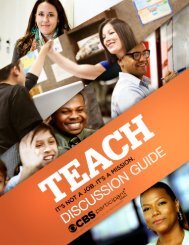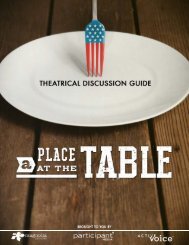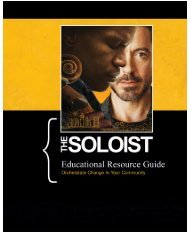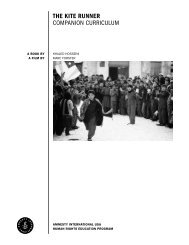Sharpen your conflict resolution skills with our activity guide - TakePart
Sharpen your conflict resolution skills with our activity guide - TakePart
Sharpen your conflict resolution skills with our activity guide - TakePart
- No tags were found...
Create successful ePaper yourself
Turn your PDF publications into a flip-book with our unique Google optimized e-Paper software.
Procedures:1. When students arrive, f<strong>our</strong> chairs should be set up in a row in the front of the room.2. After the class is settled, select six students to participate in the next <strong>activity</strong>. Ask one ofthe students to the front of the room to stand <strong>with</strong> you. Tell the other five participantsthat when you clap <strong>y<strong>our</strong></strong> hands they should come up and sit in the row of chairs, onestudent per chair. The f<strong>our</strong> people who end up in the chairs will “win.” The person whoends up <strong>with</strong>out a chair will “lose.”3. Clap <strong>y<strong>our</strong></strong> hands. The five students will scramble to get to the chairs, and, inevitably, onestudent will remain standing. A disagreement might erupt (a student claims he/she gotthere first, a student tries to shoulder his/her way onto the remaining chair, a studentcomplains that he/she was sitting farther in the back of the class and that the otherstudents had an “unfair” advantage, etc.).4. Tell the class that the student standing <strong>with</strong> you was chosen to be the judge and decidewho wins and who loses. The student does not have to explain why he/she decides theway he/she does. The class can call out their opinions. Allow students to disagree.5. Return all six students to their seats. Allow 10 minutes for the class to discuss theexperiment.6. Ask the class to describe what happened when there were five students and only f<strong>our</strong>chairs. Ask the five students who were competing for the chairs to share how they feltduring the <strong>activity</strong>. Why was it so important to “win” a chair? Ask the student who hadto decide the “loser” to describe how he/she felt. What made his/her role difficult?7. Tell the class that there are approximately 20 significant armed <strong>conflict</strong>s happeningaround the world today, and that almost every single one of them is being fought overone of two issues: power (governmental rule) or turf (land/territory).**Note: This information according to Patterns of Major Armed Conflicts, 1997-2006, by LottaHarbom and Peter Wallensteen, Uppsala Conflict Data Program, Department of Peace andConflict Research, Uppsala University8. Ask students what happened when there were five people fighting over f<strong>our</strong> chairs. Askthem what happened when there was one person who could make a decision for the largergroup. Ask: How does this relate to the statistic they just heard? Why might so manyglobal <strong>conflict</strong>s erupt over power and territory?9. Divide the class into pairs. Distribute one copy of Student Handout: Cycles of Conflict toeach pair.10. Choose one of the following prompts and write it on the chalkboard, chart paper, ordistribute it to each pair as a Student Handout: Situations of Conflict.Situation I: Adults in <strong>y<strong>our</strong></strong> community/neighborhood are tired of the noise and nuisance of youngpeople “loitering” near local restaurants, movie theatres, and parks in the evenings. For thiswww.takepart.com/JimmyCarterManFromPlains









